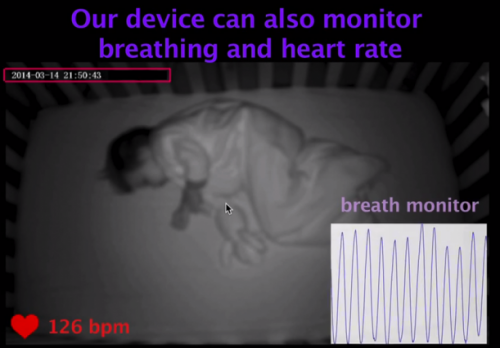Could wireless detection devices replace wearables?

These days there's perhaps no hotter tech topic than wearable sensors. Earlier this month, for instance, Apple announced a new "Health Kit" app for smartphones that tracks a person's health. But events such as Fitbit's recent recall of more than 1 million fitness bands over user skin irritations—and research published last week contending that health-trackers may be no more effective than a $25 pedometer—suggest that wearables have their drawbacks.
Imagine, then, if there was a technology that monitors your vital signs without touching your body—potentially even from another room.
Such science-fiction fantasies are becoming a reality, thanks to research conducted at MIT's Wireless Center, hosted in the Computer Science and Artificial intelligence Laboratory (CSAIL).
Last year, a CSAIL team developed a wireless system that can track movement through a wall. Their latest report demonstrates that they can now detect gestures as subtle as the rise and fall of a person's chest. From that, they can determine a person's heart rate with 99 percent accuracy. The research could be used for health-tracking apps, baby monitors, and for the military and law enforcement.
"It has traditionally been very difficult to capture such minute motions that occur at the rate of mere millimeters per second," says MIT professor of electrical engineering and computer science Dina Katabi, the paper's co-author who also directs the Wireless Center. "Being able to do so with a low-cost, accessible technology opens up the possibilities for people to be able to track their vital signs on their own."
The team—which includes Robert Miller, a professor of electrical engineering and computer science, and graduate students Fadel Adib and Zach Kabalec—has also developed the capability to track the movements of up to four distinct individuals, which could be helpful for search-and-rescue operations (such as when emergency responders are trying to find survivors inside a burning building).
As described in an earlier MIT News story, the system works by transmitting a low-power wireless signal and using its reflections to track moving humans. It can do so even if the humans are in closed rooms or hiding behind a wall.
As the signal is transmitted at a wall, a portion of the signal penetrates through, reflecting off a person on the other side. However, due to all the signal interference from other objects, the team had to create technology to cancel out irrelevant reflections.
In order to monitor breathing, the technology needed to be precise: The researchers created a complex metric that approximates the subject's volume, and then observed and amplified its changes to distinguish the breathing.
Katabi's team is now working on higher resolution capabilities that would allow them to detect actual body silhouettes, gestures, and even emotions. (Heart rate and breathing are strong indicators of emotional extremes like fear or anger.)
Provided by Massachusetts Institute of Technology
This story is republished courtesy of MIT News (web.mit.edu/newsoffice/), a popular site that covers news about MIT research, innovation and teaching.





















